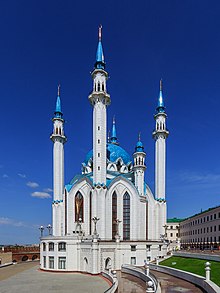Kul Sharif Mosque
This article relies largely or entirely on a single source. (May 2011) |
| Qol Şärif Mosque | |
|---|---|
 | |
| Religion | |
| Affiliation | Islam |
| District | Tatarstan |
| Status | Active |
| Location | |
| Location | Kazan, Russia |
| Geographic coordinates | 55°47′54.49″N 49°06′17.32″E / 55.7984694°N 49.1048111°E |
| Architecture | |
| Type | Mosque |
| Completed | 2005 |
| Specifications | |
| Dome(s) | 1 |
| Minaret(s) | 4 |
The Qolşärif Mosque (pronounced [kɔlʃæˈriːf], also spelled Qol Sharif, Qol Sherif and Kol Sharif via the Tatar Qol Şärif mäçete, Qolşärif mäçete, and Kul Sharif via the Russian мечеть Кул-Шариф, mechet Kul-Sharif) located in Kazan Kremlin, was reputed to be – at the time of its construction – one of the largest mosques in Russia, and in Europe outside of Istanbul.[1]
History
Originally, the mosque was built in the Kazan Kremlin in the 16th century. It was named after Qolşärif, who served there. Qolşärif died with his numerous students while defending Kazan from Russian forces in 1552. It is believed that the building featured minarets, both in the form of cupolas and tents. Its design was traditional for Volga Bulgaria, although elements of early Renaissance and Ottoman architecture could have been used as well. In 1552, during the storming of Kazan it was destroyed by Ivan The Terrible.

Tatar scholars speculate as to whether some elements of Qolşärif Mosque can be seen in Saint Basil's Cathedral in Moscow (8 minarets, a central cupola, not typical for Russian architecture). Since 1996, the mosque has been rebuilt in Kazan Kremlin, although its look is decisively modern. Its inauguration on July 24, 2005, marked the beginning of celebrations dedicated to the Millennium of Kazan. It can accommodate 6,000 worshipers.
Several countries contributed to the fund that was set up to rebuild Qolşärif Mosque, namely Saudi Arabia, and United Arab Emirates. Qolşärif is considered to be one of the most important symbols of Tatar aspirations.[citation needed] Nowadays the mosque predominantly serves as a museum of Islam. At the same time during the major Muslim celebrations thousands of people gather there to pray.
The Qolşärif complex was envisioned to be an important cornerstone of Kazan's architectural landscape. Besides the main mosque building it includes a library, publishing house and Imam's office.
See also
References
- ^ "Putin joins Tatarstan festivities". BBC News. 2005-08-26. Retrieved 2010-05-22.
External links
- "Kul Sharif (The main page)". Archived from the original on 13 September 2005. Retrieved 28 June 2009.
- Kul Sharif video
- Qol Sharif mosque on "Russian mosques"
- Qolsharif Mosque (Kazan)
